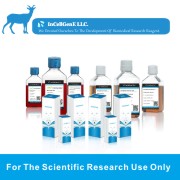

Overview
| Organism | Homo sapiens, human |
|---|---|
| Tissue | dermal endothelium |
| Cell Type | dermal microvascular endothelium |
| Product Format | frozen |
| Morphology | endothelial-like |
| Culture Properties | adherent |
| Biosafety Level |
2 [Cells contain SV-40 viral DNA sequences]
Biosafety classification is based on U.S. Public Health Service Guidelines, it is the responsibility of the customer to ensure that their facilities comply with biosafety regulations for their own country. |
| Age | newborn |
| Gender | male |
| Applications | angiogenesis, leukocyte trafficking, wound healing, inflammation, circulation, tumor growth and metastasis.cancer research, endothelium function, cell trafficking, surface molecule interactions, drug screening, toxicological studies for the pharmaceutical and cosmetic industry |
| Storage Conditions | liquid nitrogen vapor phase |
Properties
| Derivation | Microvascular endothelial cells isolated from human foreskins were transfected with pSVT vector, a pBR-322 based plasmid containing the coding region for Simian virus 40A gene product, large T antigen. |
|---|---|
| Receptor Expression | The cells express von Willebrand''s factor (vWF), cell adhesion molecules ICAM-1 and are capable of acetylated LDL uptake. Ref (Ades EW, et al. HMEC-1: Establishment of an Immortalized Human Microvascular Endotheilal Cell Line. J. Invest. Dermatol. 99(6): 683-690, 1992. PubMed: 1361507) |
| Comments | CRL-3243, HMEC-1, has been well characterized and shown to retain many of the characteristics of endothelial cells. These immortalized cells, because they are a continously renewable source of human endothelial microvascular cells, can be used as a replacement for primary human dermal endothelial cells for many research studies. |
Background
| Complete Growth Medium |
The base medium for this cell line is MCDB131 (without L-Glutamine). To make the complete growth medium, add the following components to the base medium:
|
|---|---|
| Subculturing |
Volumes used in this protocol are for 75 cm2 flasks; proportionally reduce or increase amount of dissociation medium for culture vessels of other sizes.
Subcultivation Ratio: 1:6 to 1:12 is recommended. Medium Renewal: Do not feed cells with growth medium between subcultures or cells become very tightly attached and will be difficult to disperse with trypsin-EDTA |
| Cryopreservation |
Freeze Medium: Complete growth medium, 92.5%; DMSO, 7.5%
Storage Temperature: liquid nitrogen vapor phase
|
| Culture Conditions | Temperature: 37��C |


